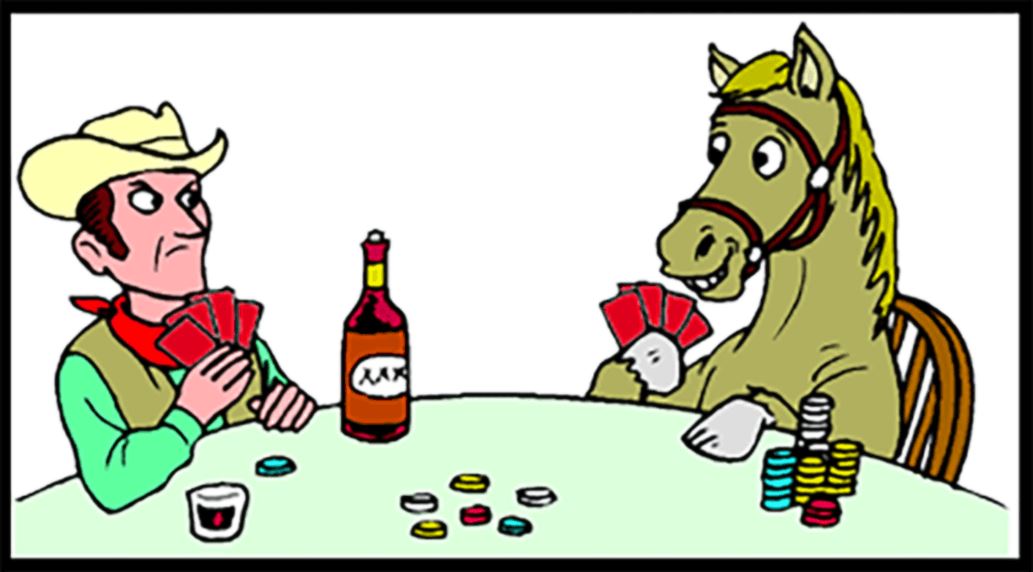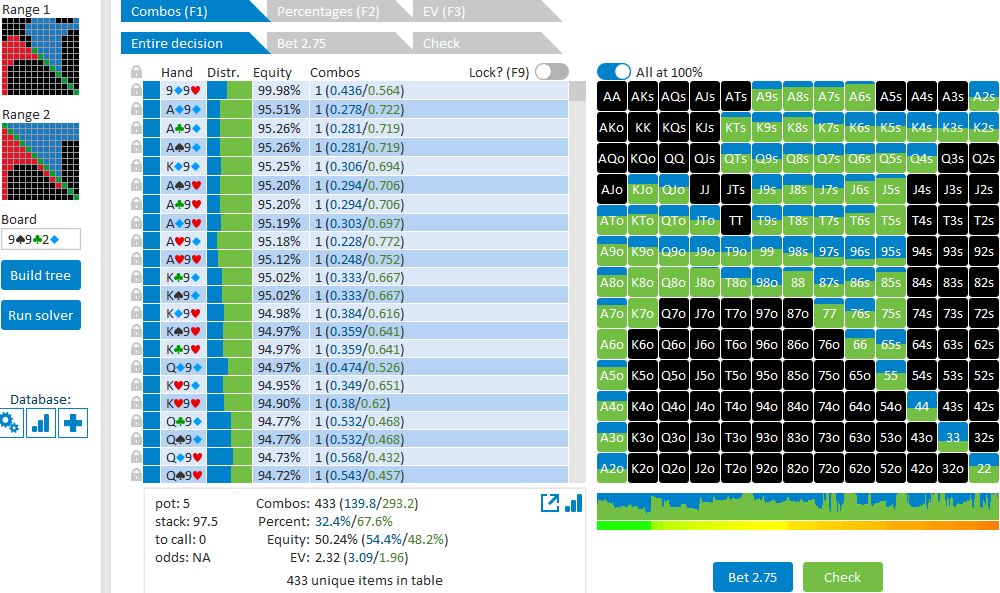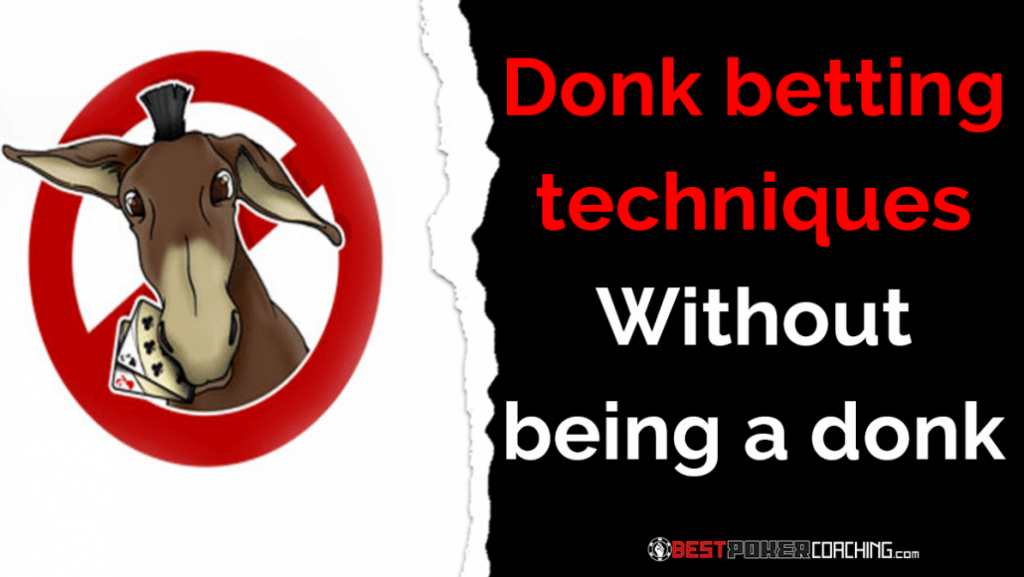I am not sure where the old donk betting bet took its name from. Means fool in Australian slang but most likely it borrowed its name from the known animal (donkey), member of the horse family. In poker terminology “donk” is a bad player (*although donkeys are considered quite intelligent beasts, a little stubborn, however).
Ok, let’s examine the origins of this bad fame for the poor donk bet. Well, according to some old school/old modern perception of the game – which by the way one can mostly meet even today-, there are many disadvantages leading the flop as the preflop defender and this is a play which should be strongly avoided. In the most optimistic criticisms, one is a bad player and doesn’t understand what poker is if he donk bets! Why you donk bet? Are you a fish?

One of the reasoning behind the badness of donk betting is related to an outdated concept, which regards gaining and/or giving away information. When you bet you are supposed to give information about your range and you don’t take information about Villain’s range. I have read this written more or less like this even from well-known players here and there.
However, I quite disagree.
First of all, Villain is unlikely to know what your betting/donk betting strategy is. And if he needs to gather 100K hands before he actually knows, then practically he doesn’t have a clue about what you are doing. He can only make assumptions based on population reads – mostly based on reads linked with the fish and their tendencies (which is way far from what you are doing – hopefully ☺).
But even if he was aware exactly of your donking game plan this doesn’t make necessarily the play bad. Assuming that a strategy with donk betting is of higher EV than one without– and in some scenarios it can be, as we will discuss later in this article– then it is clear that one should have a leading range in his repertoire.
Secondly, regarding the information we lose, still, the arguments are not clear. Although Villain is supposed to be betting polarized as the preflop aggressor, i.e. betting his strong hands for value, checking the medium strength and betting the very next part of his range, he doesn’t have to!!
One, of course, can assume that this is the case. Therefore, by donk betting, you miss some information? i.e. if you would have checked and Villain would have checked back, he usually has a hand of medium strength. But even if this is the case, what one would do with this information? If Villain has a balanced checking flop range, by checking back a part of his range doesn’t lose anything.
Old-modern school poker also suggests that you have no reason to donk bet since you miss the opportunity to check-call or check-raise. This, because the preflop aggressor is supposed to be cbetting with a high frequency. Therefore, why not let him bluff? Again, this argument is kind of vague. We are not in 2005 where cbet at a high frequency, i.e from the BTN, is enough to crush high stakes. And even if would bet with 100% frequency, this doesn’t mean that a donk bet is necessarily out of the picture of valid strategies. Of course, when you donk bet you can’t check-call or check-raise same time (this is not quantum mechanics), but this doesn’t mean that this action has necessarily less EV.
Let’s see lastly one kind of good argument for the non-goodness of donk betting. One of the main reasons that usually you shouldn’t have a leading range is that this range commonly is capped, i.e. you 3bet preflop the strong part of the deck, and therefore usually you are weaker on the flop. Why would one like to lead vs a stronger range? Also, by betting on the flop, one needs to consider what happens with his checking range. By weakening your checking range, let’s say by putting some of your strong holdings to a leading range, you are exposed theoretically vs Villain’s aggression when you check since he has a lot of equity vs your remaining holdings and he can extract a lot of value. With his range advantage vs your checking range, he can apply a lot of pressure, pushing you out of many pots.
These concerns are legitimate. However, with some lack of accuracy. They are true, but only under certain conditions which not necessarily apply always.
But why one would like to donk bet after all? Why add more complexity?
And my answer to this passes through a question: where the edge comes from in poker?
And there is only one correct answer here. It comes from our ability to play a game where our skills are better than those of our opponents. And this means that we should be willing to push the game into territories where Villain feels uncomfortable. *Or even if he doesn’t feel uncomfortable, to territories where we maximize our EV.
Additionally, from a theoretical point of view, a donk betting range is not forbidden. Actually, is a lot better than a zero donking range in some cases. And one could argue like a “donk” why a donking betting range is good. 1) We take the initiative 2) we neglect equity from Villain, i.e. he can’t now check back and realize his equity 3) we take value/protect our good holdings 4) Villain will not adapt correctly because he is going to make wrong assumptions about our strategy 5)… But all these are “donk” arguments. Because still they lack of accuracy. They can or cannot be true under certain conditions.
**On a side note, this is a big problem in the poker community. Everyone knows everything, and all together make some nice stories, but at the end of the day who pays the bill?:)
What really matters is one thing. And nothing else really matters (assuming that we don’t take into account Villain’s type and possible exploits).

Our range vs Villain’s range on a particular board texture.
And there are boards and scenarios where a leading range makes sense!! Maybe, in the most common situation where BTN opens and BB calls, these are not too many.
But let me show you an example where this is a valid strategy, even BB vs BTN. The hero is BB and flats preflop vs a BTN open and the flop comes 9s9c2d (see Figure 1). One can see, according to the solver, that hero can implement a donking range with a frequency around 32%.
Why this? Well, the simulator doesn’t understand about donks, initiative, preflop aggressors etc. What understands very well, however, is equity. In this specific board, it is very easy to see that the defender has many 9x, and these 9x combos are a big portion of the whole range. The aggressor on the other side, has as many 9x, however, his range is wider (therefore the 9x part of his range is a smaller portion).
Indeed, both ranges have 57 combos of three of a kind, however, the preflop aggressor on this board has all the broadways combos as well (and now it can be of his trouble to defend them vs a donk bet on this board!!).

Figure 1: A donk betting range – BB vs BTN – hero is BB and flats preflop (Range 1) vs BTN open (Range 2). *The defender mostly 3bets with the broadways preflop = he has more combos in his range as a % of the total range which connect with the board.
Therefore, the defender now can be offensive.
The way to construct the leading range is not unfamiliar. The polarized way it is!! – with some precautious – is going to give a solid plan. BB can start by betting (roughly half of the times) his 9x. Check with a plan to check-call with some Ax and medium pocket pairs (pp). And bet as a bluff either with small pp, which need protection or with some suited combos with overcards (i.e. KXs,QXs) and/or gutshots/bckdr fd.
Notice, that the checking range is protected, still, BB keeps some of his 9x in it (so it is not capped).
Also, notice, that nobody prohibits BB from constructing a check-raising range as well, both for value (some 9x) and as a bluff.
And what BTN is going to do vs such a game plan? Even if he knows all of it!!? Raise? Call? Fold? Well, BTN needs to play defense and a good one vs this strategy, even though he is the preflop aggressor and he has all the over pairs in his range.
Now, having this discussed, there are other scenarios, not in the BB vs BTN one, where a donking range also makes a lot of sense. These include a donking rage on the turn, a donking range on the river, a donking range on 3bet pots, a donking range on multiway pots and others.
I leave the rest for future articles.
The important here is to realize that our perception for the game needs to be connected mostly with our equity and our range vs Villain’s range. If one forgets to include an equity discussion with a very accurate analysis regarding its distribution vs Villain’s equity, can be lead to funny conclusions, like the ones that dominate many of the poker forums.




